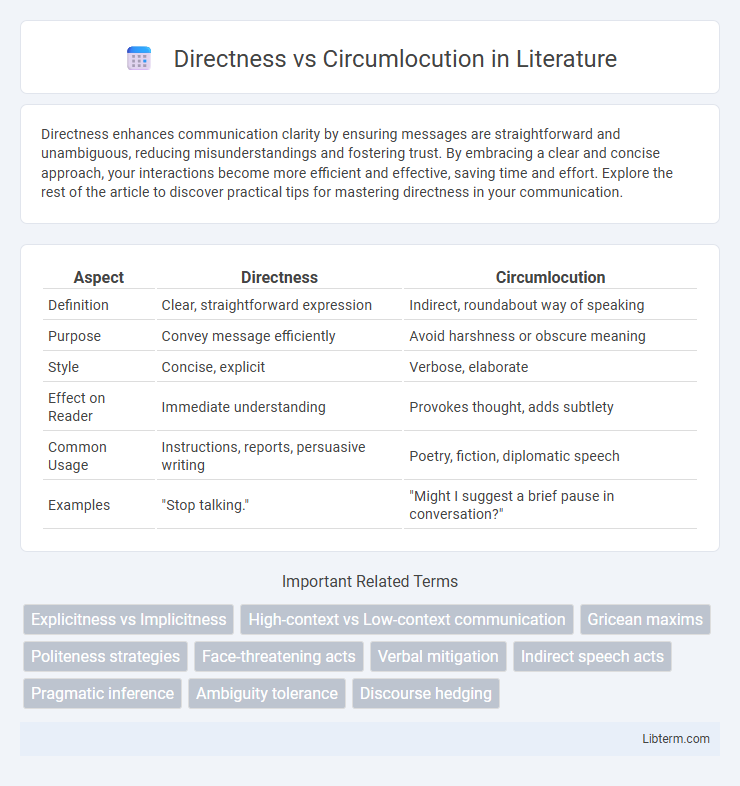Directness enhances communication clarity by ensuring messages are straightforward and unambiguous, reducing misunderstandings and fostering trust. By embracing a clear and concise approach, your interactions become more efficient and effective, saving time and effort. Explore the rest of the article to discover practical tips for mastering directness in your communication.
Table of Comparison
| Aspect | Directness | Circumlocution |
|---|---|---|
| Definition | Clear, straightforward expression | Indirect, roundabout way of speaking |
| Purpose | Convey message efficiently | Avoid harshness or obscure meaning |
| Style | Concise, explicit | Verbose, elaborate |
| Effect on Reader | Immediate understanding | Provokes thought, adds subtlety |
| Common Usage | Instructions, reports, persuasive writing | Poetry, fiction, diplomatic speech |
| Examples | "Stop talking." | "Might I suggest a brief pause in conversation?" |
Understanding Directness and Circumlocution
Understanding directness involves clear, straightforward communication that conveys messages without ambiguity, ensuring efficient information transfer. Circumlocution, in contrast, uses indirect or roundabout expressions, often to avoid sensitive topics or when lacking precise vocabulary. Mastering the balance between directness and circumlocution enhances interpersonal communication by adapting tone and clarity to context and audience needs.
Cultural Influences on Communication Styles
Directness in communication is often valued in cultures such as the United States and Germany, where clarity and efficiency promote straightforward expression of ideas. In contrast, cultures like Japan and India may favor circumlocution, using indirect language and nuanced expressions to maintain harmony and show respect. Understanding these cultural influences is crucial for effective intercultural communication, as it helps navigate differing expectations regarding honesty, politeness, and the avoidance of confrontation.
The Psychology Behind Speaking Directly
Speaking directly often reflects cognitive clarity and confidence, allowing the speaker to communicate intentions and emotions with minimal ambiguity. Psychological studies associate directness with assertiveness and transparency, which can foster trust and reduce misunderstandings in interpersonal communication. Conversely, circumlocution may signal uncertainty, social discomfort, or attempts to soften potentially confrontational messages.
Benefits of Direct Communication
Direct communication enhances clarity by minimizing misunderstandings and ensuring messages are conveyed efficiently, saving time for all parties involved. It fosters transparency and trust in relationships by expressing intentions and expectations clearly, which improves collaboration and decision-making. This approach also reduces ambiguity, allowing quicker problem resolution and stronger alignment within teams or organizations.
Drawbacks of Circumlocution in Conversation
Circumlocution in conversation often leads to confusion and misunderstanding due to its indirect nature, making communication less efficient. It can frustrate listeners who seek clear and concise information, reducing overall engagement and trust. Excessive use of circumlocution may also signal a lack of confidence or knowledge, undermining the speaker's credibility.
When to Choose Directness or Circumlocution
Choose directness when clarity and efficiency are paramount, such as in business communications, instructions, or emergency situations where messages must be understood immediately. Circumlocution suits contexts requiring tact, diplomacy, or sensitivity, helping to soften criticism or navigate social nuances without causing offense. Assess the audience, purpose, and cultural context to determine whether straightforward language or a more roundabout expression best achieves the communication goal.
Directness vs Circumlocution in Business Settings
Directness in business communication promotes clarity, efficiency, and timely decision-making, minimizing misunderstandings and enhancing productivity. Circumlocution, while sometimes used to soften messages or navigate sensitive topics, can lead to confusion, delays, and decreased trust among colleagues and clients. Prioritizing direct language helps establish transparent relationships and fosters a results-oriented corporate culture.
Impact on Relationships and Social Dynamics
Directness fosters clarity and trust in relationships by reducing misunderstandings and promoting honest communication, which strengthens social bonds. Circumlocution, while sometimes employed to soften messages or avoid conflict, can create confusion and hinder genuine connection, potentially leading to frustration or mistrust. Balancing directness with tact enhances social dynamics by respecting emotional sensitivities while maintaining transparency in interactions.
Mastering the Balance: Tips and Strategies
Mastering the balance between directness and circumlocution enhances communication effectiveness by tailoring clarity and nuance to the audience's needs. Employing concise language improves message precision, while strategic elaboration provides context and politeness, preventing misinterpretation. Techniques such as active listening, audience analysis, and iterative feedback refine this equilibrium, fostering more impactful interpersonal and professional interactions.
Real-Life Examples of Directness and Circumlocution
Directness is demonstrated in situations like job interviews where candidates respond concisely to questions, providing clear and specific answers to showcase their qualifications effectively. Circumlocution appears in diplomatic communications, where ambassadors use vague or indirect language to address sensitive issues without causing offense or revealing explicit stances. In customer service, directness involves straightforward problem-solving instructions, while circumlocution may be used to soften refusals or delay responses, balancing clarity with politeness.
Directness Infographic

 libterm.com
libterm.com